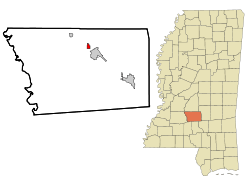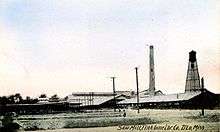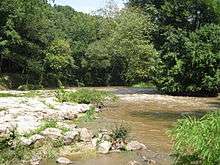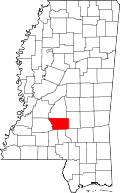D'Lo, Mississippi
| D'Lo, Mississippi | |
|---|---|
| Town | |
 Location of D'Lo, Mississippi | |
 D'Lo, Mississippi Location in the United States | |
| Coordinates: 31°59′12″N 89°54′4″W / 31.98667°N 89.90111°WCoordinates: 31°59′12″N 89°54′4″W / 31.98667°N 89.90111°W | |
| Country | United States |
| State | Mississippi |
| County | Simpson |
| Government | |
| • Mayor | John Henry Berry |
| • Mayor Pro-tem | Ruth Griffin |
| Area | |
| • Total | 0.7 sq mi (1.8 km2) |
| • Land | 0.7 sq mi (1.8 km2) |
| • Water | 0.0 sq mi (0.0 km2) |
| Elevation | 299 ft (91 m) |
| Population (2010) | |
| • Total | 452 |
| • Estimate (2016)[1] | 447 |
| • Density | 650/sq mi (250/km2) |
| Time zone | UTC-6 (Central (CST)) |
| • Summer (DST) | UTC-5 (CDT) |
| ZIP code | 39062 |
| Area code(s) | 601 |
| FIPS code | 28-19340 |
| GNIS feature ID | 0669070 |
D'Lo is a town in Simpson County, Mississippi, United States, along the Strong River. The population was 394 at the 2000 census. Known as Millhaven until 1950, it is part of the Jackson Metropolitan Statistical Area.
The town was featured in Life magazine for sending more men per capita to serve in World War II than any other town of its size; 38 percent of the men who lived in D'Lo served.[2]
In 2016 the town was featured on the UP reality TV series, Small Town, Big Mayor.[3]
Geography
According to the United States Census Bureau, the town has a total area of 0.7-square-mile (1.8 km2), all land.
History
D'Lo was known as the village of Millhaven from the early 19th century to 1950, due to the many watermills that were built along the Strong River in that area. It was not until 1874, nearly a decade after the end of the Civil War, that the first home was built there, and the population began to grow slowly. The post office was established May 23, 1881, with Mary F. May as first postmaster.
After 1881 the Gulf and Ship Island Railroad constructed tracks through Millhaven, stimulating a surge in population. As a result of the growth of the community, on October 27, 1905, Governor James K. Vardaman declared D'Lo an official town.

The town expanded more in 1916 when the Finkbine Lumber Company chose it as the location for a $1,000,000 sawmill plant. Finkbine constructed many houses in the community for their workers, as well as a combination drygoods, hardware, grocery store, farm supply, feed and seed, and general store known as Kew Mercantile Company.
During the peak of the Finkbine’s sawmill plant operation, between 1916 and 1930, Millhaven was recognized as the largest town between Jackson and Hattiesburg. It had two large YMCA buildings, a movie theater, ten grocery stores, a furniture store, three appliance dealers, ten gas stations, seven butcher's markets, a dry cleaner, five cafes, three auto shops, a boat building and cabinet shop, a machine shop, three pharmacies, a bank, lighted basketball courts, professional basketball and baseball teams, and a newspaper called The D'Lo Herald.
The town also had Baptist and Methodist churches, and a three-story brick school with 550 students and 17 teachers. Its three-story Pine View Hospital was considered the best hospital between Jackson and the Mississippi Gulf Coast, as far as equipment and doctors were concerned. During this time the population of Millhaven was estimated to be around 5,000, which made it the second largest milling town in the United States. However, by the 1930s the Finkbine Mill had consumed almost all the timber in the surrounding counties, and the plant was shut down.
With the Finkbine sawmill closed, Millhaven lost jobs and suffered a major decline in population. It took several years for the town's economy to begin to recover. With the construction of U.S. Route 49 through the town, Lumber companies could reach second-growth of timber in the surrounding areas. A new hardwood sawmill reportedly supplied timber to firms that built weapons and equipment for World War II. Although the mill was effective at keeping the town going for many years, it was never a large enough operation to recoup the huge loss of population. Once with a population of 5,000, during the 1940s, the town had around 400 residents. This is the estimated population in the 21st century.
Of the town's population of about 400, around 150 males served in the Armed Forces during World War II. About 46 volunteers also served prior to the bombing of Pearl Harbor. So many citizens served in the war that the town's story was featured in the July 6, 1942 edition of Life magazine. The story featured a picture of two young boys standing in the deserted streets of D'Lo with the headline, "D'Lo Men Have Gone Off to War", with a caption that stated, "There is a war and a country is in danger. When that happens the men drop what they are doing and go off from the deep southern hamlet of D'Lo, Miss." A monument located at the town's community center lists the D'Lo citizens who served during the war.
The name was changed to D'Lo effective January 1, 1950.[4]
Etymology
The most controversial piece of D'Lo history is the origins of the name itself. Three different stories explain how the odd name originated. The oldest and probably the most common story claims that an early settler referred to this area along the Strong River, where it commonly floods, as being "too damn low". When it came time for the village to get a post office, he suggested that the village be named "too damn low", but the postal authorities would not approve of the name because of the profanity. Someone supposedly suggested the name "D-Low", which over the years was shortened to "D'Lo".
Another account said that Millhaven was rejected by the postal authorities as a town name. Purportedly the US Postal Service provided the village with a list of alternative four-letter names for the residents to choose from. Among these names was one spelled "Delo". After the citizens chose this name, a penman prepared a letter to be sent back to the authorities informing them of the name they had chosen. The letter was written in a script that may have put the lower case "e" in Delo above the "lo". The story concludes that the little "e" was probably misinterpreted as an apostrophe and therefore the post office documented the village name as being D'Lo.
The last version also says that the postal authorities rejected the name Millhaven. The residents of the village were said to suggest the new name "De Leau". This name was submitted and approved by the postmaster, but was later shortened to D'Lo. Although this story seemed far-fetched, the University of Southern Mississippi has proven that old maps by 16th-century French explorers labeled this area around the Strong River with the words "De l'eau sans potable". This translates as "bad drinking water".
Demographics
| Historical population | |||
|---|---|---|---|
| Census | Pop. | %± | |
| 1910 | 284 | — | |
| 1920 | 646 | 127.5% | |
| 1930 | 514 | −20.4% | |
| 1940 | 400 | −22.2% | |
| 1950 | 516 | 29.0% | |
| 1960 | 428 | −17.1% | |
| 1970 | 485 | 13.3% | |
| 1980 | 463 | −4.5% | |
| 1990 | 421 | −9.1% | |
| 2000 | 394 | −6.4% | |
| 2010 | 452 | 14.7% | |
| Est. 2016 | 447 | [1] | −1.1% |
| U.S. Decennial Census[5] | |||
As of the census[6] of 2000, there were 394 people, 179 households, and 114 families residing in the town. The population density was 569.7 people per square mile (220.5/km²). There were 206 housing units at an average density of 297.8 per square mile (115.3/km²). The racial makeup of the town was 79.19% White, 19.54% African American, 0.51% Native American, 0.25% Pacific Islander, and 0.51% from two or more races.
There were 179 households out of which 24.0% had children under the age of 18 living with them, 50.3% were married couples living together, 10.6% had a female householder with no husband present, and 35.8% were non-families. 34.1% of all households were made up of individuals and 19.0% had someone living alone who was 65 years of age or older. The average household size was 2.20 and the average family size was 2.77.
In the town, the population was spread out with 20.3% under the age of 18, 9.6% from 18 to 24, 22.6% from 25 to 44, 27.9% from 45 to 64, and 19.5% who were 65 years of age or older. The median age was 42 years. For every 100 females, there were 79.9 males. For every 100 females age 18 and over, there were 81.5 males.
The median income for a household in the town was $28,750, and the median income for a family was $33,125. Males had a median income of $27,500 versus $21,731 for females. The per capita income for the town was $15,469. About 11.7% of families and 13.7% of the population were below the poverty line, including 15.6% of those under age 18 and 17.6% of those age 65 or over.
Education
The Town of D'Lo is served by the Simpson County School District.
Entertainment attractions

D'Lo has a water park on the Strong River, called D'Lo Water Park. A one-screen movie theatre, called the "Lux Theatre", closed in the 1950s.
Popular culture
- A portion of the 2000 film O Brother, Where Art Thou?, known as the "Siren Scene", was filmed on the banks of the Strong River at the D'Lo Water Park.
Notable people
- Joe L. Allbritton (1924–2012), businessman
- Fred James Cassibry, United States federal judge
- Patrick D. Smith, author
- Sylvanus Powell Weathersby, Sr. (born 1887), Doctor of Veterinary Medicine.[7] Following graduation from the Department of Agriculture at Tuskegee Institute in 1915, he was unable to gain admission to any of the US veterinary schools and was admitted to the Ontario Veterinary College in Guelph, Ontario. Upon graduation in 1920 he returned to his home in D'Lo, where he practiced for 48 years. He was the first African American veterinarian in Mississippi.[8] His two sons would matriculate much later at the new veterinary school at the Tuskegee Institute. He lived in what is referred to as the D'Lo Flat.
References
- 1 2 "Population and Housing Unit Estimates". Census.gov. Retrieved June 9, 2017.
- ↑ "Archived copy". Archived from the original on 2009-10-23. Retrieved 2009-05-23.
- ↑ "D'Lo, mayor featured in reality show". Clarionledger.com. Retrieved 6 December 2017.
- ↑ Gallagher, John S. and Patera, Alan H. (1996) Mississippi Post Offices, p. 155. Lake Grove, Oregon: The Depot; ISBN 0-943645-35-2 The change of designation is recorded in the U.S. Official Postal Guide, part I, July 1951, p. 746.
- ↑ "Census of Population and Housing". Census.gov. Archived from the original on May 12, 2015. Retrieved June 4, 2015.
- ↑ "American FactFinder". United States Census Bureau. Archived from the original on 2013-09-11. Retrieved 2008-01-31.
- ↑ Adams, Eugene W. (2004). "A Historical Overview of African American Veterinarians in the United States: 1889–2000" (PDF). Journal of Veterinary Medicine Education. 31 (4): 409–23. Archived from the original (PDF) on 2010-06-26.
- ↑ Eve, Dianne (2002). The Life of Sylvanus Powell Weathersby: The First African American Veterinarian in Mississippi (PDF). Masters of Arts Thesis, The Graduate School at Jackson State University, Jackson, MS.
